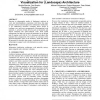Free Online Productivity Tools
i2Speak
i2Symbol
i2OCR
iTex2Img
iWeb2Print
iWeb2Shot
i2Type
iPdf2Split
iPdf2Merge
i2Bopomofo
i2Arabic
i2Style
i2Image
i2PDF
iLatex2Rtf
Sci2ools
INFOVIS
2000
IEEE
2000
IEEE
Creativity, Complexity, and Precision: Information Visualization for (Landscape) Architecture
Drawing on ethnographic studies of (landscape) architects at work, and interdisciplinary cooperation with them, this paper presents a human-centered approach to information visualization. A 3D collaborative electronic workspace allows people to configure, save, and browse arrangements of heterogeneous work materials. A network of links between parts of documents and objects underpins this spatio-temporal order. Both spatial arrangements and links are created and maintained as an integral part of ongoing work with the ‘live’ documents and objects that populate these arrangements. The result is an extension of the physical information space of the architects’ studio that utilizes the potential of electronic data storage, visualization, and network technologies to support work with information in context. Keywords Information visualization, architecture, work materials, context, spatio-temporal order, electronic workspace
| Added | 31 Jul 2010 |
| Updated | 31 Jul 2010 |
| Type | Conference |
| Year | 2000 |
| Where | INFOVIS |
| Authors | Monika Büscher, Dan Shapiro, Michael Christensen, Preben Mogensen, Peter Ørbæk |
Comments (0)

